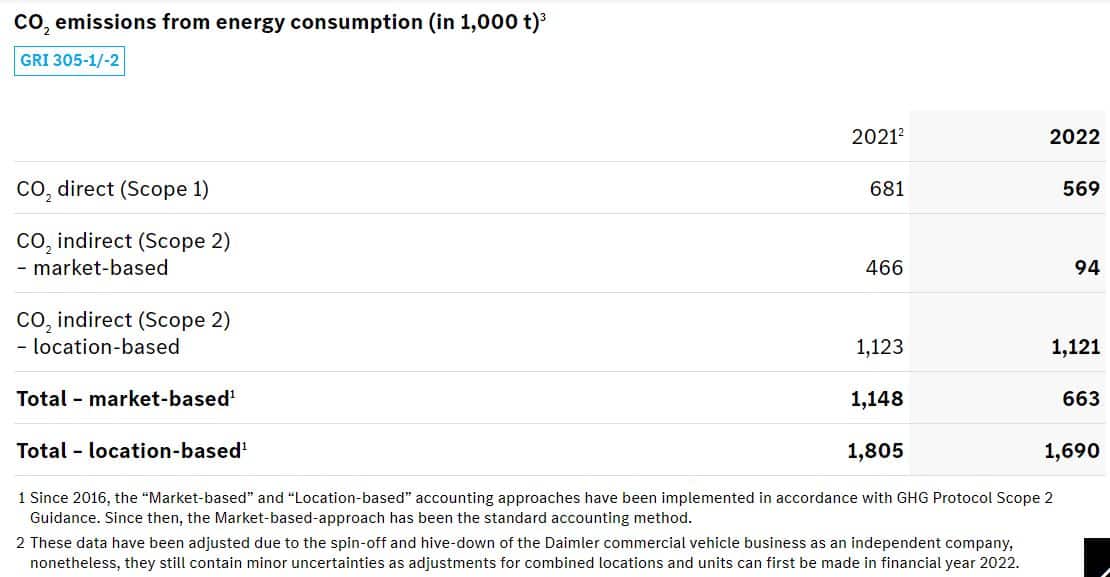Mercedes-Benz announced that they sold 56,300 electric vehicles (EVs) in Q2, up 123% from the same quarter in previous year. This affirms the German luxury carmaker’s commitment to reducing its carbon emissions and bringing its new fleet to net zero across the value chain by 2039.
Fully EVs now account for 11% of Mercedes-Benz overall sales year-to-date that’s also up by 6% in Q2. The sales were bolstered by strong demand for EVs particularly in Germany and the U.S.
Increasing this percentage is crucial for the company to continuously reduce and eliminate its carbon emissions.
Mercedes-Benz’s Carbon Footprint
The luxury carmaker has been accounting for its carbon emissions – Scope 1 and Scope 2 – in accordance with standard protocols.
In 2022, Mercedes-Benz has the following carbon emissions, which don’t include Scope 3 accounting. The first table is for its entire operations while the second is specific CO2 emissions per vehicle type.


Mercedes-Benz Climate Pledge and Transform to Net Zero
The luxury car brand aims to go all electric by 2030 as part of its ambitious electrification and decarbonization goals. In detail, here are the company’s climate targets and its progress as of 2022.

The German automaker joined Amazon’s initiative “The Climate Pledge” aimed at contributing to meeting the Paris goals ten years earlier. In signing the agreement, Mercedes-Benz agrees to:
- Measure and report GHG emissions regularly,
- Implement decarbonization strategies in line with the Paris Agreement, and
- Invest in initiatives that compensate unavoidable emissions with real, additional, permanent, and quantifiable carbon offset credits.
The carmaker joined the Amazon and Global Optimism climate pact in 2020, supporting it with its own decarbonization initiative – the Ambition 2039. This ambition means making the entire new vehicle fleet of the company carbon neutral across the value chain by 2039.
In the same year, Mercedes-Benz Vans and Amazon revealed the largest order by Amazon for EVs from the German carmaker. The giant retailer ordered over 1,800 battery-electric vehicles for use across Europe.
About ⅕ of total GHG emissions in Europe are a result of transporting people and goods. The Stuttgart-based carmaker is taking actions to address this trend and integrate climate change mitigation into its core business strategy.
Hence, Mercedes-Benz is also a founding member of “Transform to Net Zero“, a climate initiative of nine large companies and launched by Microsoft. Its goal is to pool the companies’ expertise to create positive conditions for a broader decarbonization of the economy and society.
Emphasizing the importance of this net zero transformation, the company’s COO Markus Schäfer said that:
“With Ambition 2039, we have marked out a way for Mercedes-Benz to bring our new car fleet to “net zero CO2” within less than 20 years – and not only in driving operations, but along the entire value chain. Starting in 2022, our passenger cars and vans will be produced CO2-neutrally in the more than 30 plants of Mercedes-Benz AG worldwide.”
Directly Sourcing Lithium for Sustainable Electrification
One big part of turning those ambitions into reality is by securing high-quality lithium for EV battery production. Directly sourcing this mineral is vital for Mercedes-Benz to scale up its fully EV production.
Lithium hydroxide is needed for the production of lithium-ion batteries used in the German carmaker’s EVs.
Last year, the automaker inked a supply deal with Canadian-German-start-up Rock Tech Lithium for the supply of battery-grade lithium hydroxide. The deal provides that both companies work together to create a roadmap to achieving carbon neutral lithium production by 2030.
Their partnership was revealed after the signing of agreement between Mercedes-Benz AG and Canada to explore more cooperation across the automotive value chain, focusing on natural resources development. Responsibly mined and processed materials like lithium are key for achieving a sustainable electrification of Mercedes-Benz entire vehicle fleet.
The U.S. is also in desperate need of a massive supply of domestic lithium to get to net zero. American Lithium Corporation, which has two of the largest lithium deposits in the Americas, aims to fill in the huge gap in supply and demand for this critical mineral.
And as demand for luxury electric vehicles continues to rise, so too is Mercedes-Benz’s need for more lithium. In choosing resource sourcing partners, the German automaker decides based on protection of human rights and the environment.
Ultimately, Mercedes-Benz never stops working on finding ways to further cut down its CO₂ emissions as well as the amount of rare metals needed for each electric vehicle it manufactures.

